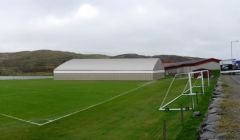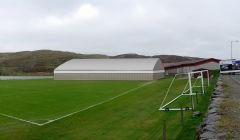Sport / Organic material the preferred infill option for new 3G pitch
A planning application has now been submitted for the pitch at the Clickimin, which could be used all year round and support the growth of sports in Shetland
IT APPEARS the proposed new 3G artificial sports pitch in Lerwick will not use controversial rubber infill – and is set to contain organic material instead.
There has been repeated concern raised over the use of crumb rubber infill in 3G pitches, with the EU for instance adopting a ban on the sale of “intentionally added microplastics” from 2031.
A recent study by Stirling University also suggested that this infill on artificial 3G pitches should be replaced with alternative material due to potentially cancerous chemicals.
Rubber, often taken from old car tyres, has historically been the preferred infill material in the UK because of benefits over performance, durability and economy.
But a document in a recently submitted planning application for Shetland Islands Council’s proposed new Lerwick pitch confirms that due to concerns over rubber infill, plus the sensitivity of the nearby Clickimin Loch and the wider environment, an organic infill material is the preferred choice.
The planning statement does not specify which material would be used, but it says organic infill could include the likes of granulated cork, olive stones or wood particles.
“Once installed the pitch will be the first fully recyclable organically infilled field in the north of Scotland and will further strengthen SIC’s position as leading the way in sustainable construction and development,” the planning statement added.
There are also other proposed methods of minimising infill loss from the pitch, including boot cleaning stations, surrounding paving and drainage inspection chambers,
A spokesperson for the SIC said: “In this application it was confirmed that an organic performance infill material will be the preferred choice for the new pitch.
“The infill will require to be suitable for both football and rugby as well as the local climate.
“Therefore, the main considerations in the final selection of the infill will be its abrasiveness, resistance to weathering and drainage properties.”
Become a member of Shetland News
The new 3G pitch would replace the rugby pitch at the north end of the Clickimin site, and previous estimates suggested it could cost around £1.2 million.
It would support year-round activity in sports like football and rugby and it is said it would boost the development of sports in Shetland given that grass pitches are often affected by the elements.
The pitch it would replace is regularly waterlogged, leading to cancelled fixtures.
A significant chunk of the cost would be met by external funding – more than half – with the Scottish Football Association for instance offering £500,000.
There is also set to be a 113-seat spectator stand installed as part of the project, and six floodlight masts.
The proposed hours of operation are 8am to 10pm, seven days a week.
The planning statement concludes that the proposals “seek to bring a poorly drained grass pitch into year-round availability through installing a new synthetic turf surface that is constructed using the latest green technology including organic infill materials and bio-based plastics”.
Local Green councillor Alex Armitage said the issue of rubber infill is something marine environment organisation KIMO UK, which has a base in Shetland, has been campaigning on for years.
“One of the noticeable aspects of climate change is the increased frequency of heavy rainfall,” the Shetland South member said.
“We have to recognise in Shetland that chemical or particulate products that we use in our environment will inevitably end up in our lochs, burns and eventually in the sea, much faster than before.
“Our marine environment is precious, not only for its own sake, but because it helps sustain a fishing industry that is the backbone of our economy.”
Another person who has shown a particular interest in the proposed 3G pitch in Lerwick is an ex-town councillor from Hadleigh, Suffolk.
Despite his geographical distance, Huw Roberts wrote to the SIC about his concerns over 3G pitches after his own local council decided against one due to environmental concerns.
Roberts welcomed news that the SIC is not going to use rubber crumb infill at the Clickimin, “as it would pose a real environmental risk to the area”.
But he said there remain “several other problems” with 3G pitches regardless of the infill material used, including the “presence of ‘forever’ chemicals (PFAS), the lack of adequate disposal and recycling facilities for end-of-life 3G pitches, and the impact on biodiversity and carbon reduction”.
“The environmental benefits of having natural grass pitches, well-maintained, can often be overlooked in the drive for alleged all-weather access and the lure of large grants,” Roberts said.
“The UK is a member of the High Ambition Coalition to End Plastic Pollution and have signed a statement calling for a global plastic pollution treaty by the end of this year.
“At the same time, the UK government, through various grant-giving bodies, is funding a massive 3G artificial pitch building programme, turning over an additional estimated 8.2 million square metres of open land to plastic by 2030.
“The environmental damage this would cause is significant. The organisation Plastic Free Fields is trying to raise awareness of the issue before it’s too late.”
Become a member of Shetland News
Shetland News is asking its readers to consider paying for membership to get additional perks:
- Removal of third-party ads;
- Bookmark posts to read later;
- Exclusive curated weekly newsletter;
- Hide membership messages;
- Comments open for discussion.
If you appreciate what we do and feel strongly about impartial local journalism, then please become a member of Shetland News by either making a single payment, or setting up a monthly, quarterly or yearly subscription.



























